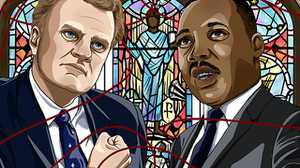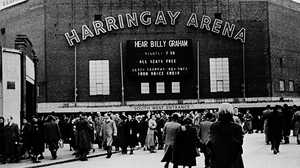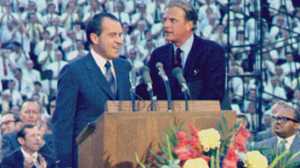A Preacher in the City of Angels
How Billy Graham’s 1949 Los Angeles Revival put him—and Evangelical Christianity—on the national map.

A desperate Billy Graham dropped to his knees, placed his Bible on a tree stump and asked God for help. By summer 1949, the 30-year-old evangelical preacher was in the throes of a spiritual crisis. For some time, he and a close friend and fellow evangelist had been debating how to understand the Bible. Were contemporary supplicants meant to read scriptures for figurative meaning or take them literally? Eventually, in his autobiography, Graham would outline the consequences of the conflict for himself at this moment. “If I could not trust the Bible, I could not go on,” he would write. “I would have to leave pulpit evangelism. I was only thirty years of age. It was not too late to become a dairy farmer.”
Hoping for an answer, Graham went off into the mountains at a Christian retreat center outside Los Angeles. Years later he would explain the revelation he had among the pines, his Bible open before him. Sensing “the presence and power of God,” Graham pledged to take the Good Book on faith: “Come what may, without question or falter, I believe this as your holy word.” Having passed through his hermeneutical crossroads, Graham emerged with new clarity. When he arrived in Los Angeles in mid-September, he was firm in his conviction to proclaim the gospel as it was written.
Graham would need that confidence. Waiting for him near the city’s central shopping district, at the corner of Hill Street and Washington Boulevard, was a canvas Ringling Brothers tent set to seat 6,000. He was meant to fill it every night for three weeks. Graham had accepted an invitation from the Christian Businessmen’s Committee of Los Angeles to headline an evangelical revival. He had already preached for the Committee at a Youth for Christ rally at the Hollywood Bowl in 1947, having begun his career as an evangelist for the organization, which provided spiritual entertainment for young adults. But with this 1949 event, he would be the star.

The Committee had already put a tremendous marketing push behind the revival, but Graham negotiated for even more. A record amount of funding was put toward posters, flyers and other advertising; letters were sent to radio stations; supporters took to the streets to publicize Graham’s return to Los Angeles. Ads sponsored by hundreds of area churches touted the revival’s “steeple of light,” a spotlight aimed above the tent hundreds of feet into the sky. At a press conference, Los Angeles mayor Fletcher Bowron declared that “the Billy Graham meetings have as their objective the reaching of individuals with a Christian message and getting them into the churches of Los Angeles. Such a program can only result in great benefit to the city.”
Two days before the program was scheduled to begin, on September 23, 1949, President Truman told Americans that the Soviet Union had just successfully tested an atomic bomb. Graham set an urgent tone in his first sermon, tying the nuclear development to his religious crusade. “We’re living at a moment in world history in which God is giving us a desperate choice,” he boomed. “And I believe the choice is either revival, or judgment.” It was a refrain to which he would return throughout the program’s run: Americans’ salvation depended on Christian conversion.
In addition to speaking to his listeners’ fears, he also previewed the company they might keep if they returned to hear him again. “We already have reservations from some of the movie people for tomorrow evening,” he offered, suggesting the revival would draw Hollywood movers and shakers, themselves in great need of repentance. The “great canvas cathedral,” as the Daily News would call it, was christened.
But media coverage faded after the first week. Neither Graham’s political intonations nor the promise of Hollywood star power was enough to fill the tent. On most nights, the tabernacle was about half full. Still, hoping traffic would pick up, the Christian Businessmen’s Committee of Los Angeles decided to extend the revival for another week.

The Committee’s efforts to bring attention to the revival bore fruit. Or as Graham would later interpret it in his autobiography, “the Lord had unfinished business to do in the lives of people who were just beginning to hear about the meetings and think about the Gospel.” Early in the fourth week, a new crowd of reporters joined the revival-goers on the tent’s sawdust-covered floor. Graham asked one of them what was happening and was told “you have been kissed by William Randolph Hearst.”
Hearst was the country’s first and most powerful media magnate. At the height of his fortune in 1935, his empire included 28 newspapers, 18 magazines, syndicated news services and several radio stations and movie companies. Now 86 years old, Hearst found his vast power over American media, and therefore American life, had waned. But the Hearst Corporation still held a portfolio of newspapers and magazines, and the man himself continued to exert editorial influence over them.
Hearst had already taken an interest in young evangelicals several years earlier. In a 1945 memo to the editors of “All Hearst Papers,” his instructions were direct: “Please keep up your interest in the Youth for Christ movement—and not with just one or two articles, but have articles continually. On the days of the meetings have illustrated articles in the news columns, and on the days after the meetings have illustrated accounts of what occurred. The movement will probably be very general and I think it would be a good thing for our papers to be the promoters of it.”
In 1949, Graham held further appeal for Hearst. The publisher was a rabid anti-communist who for years used his media outlets as platform for a relentless campaign against Communist influences in the United States. Graham shared Hearst’s antipathy towards communism and was essentially preaching the tycoon’s positions from the pulpit. Western culture and its fruits had its foundation in the Bible,” he thundered inside the tent. “Communism, on the other hand, has decided against God, against Christ, against the Bible and against all religion...Communism is a religion that is inspired, directed and motivated by the Devil himself who has declared war against Almighty God.”
The stakes for Christian revival, in Graham’s terms, were no less than the survival of the western world, and his potential to sell papers was likely not lost on Hearst. Graham exuded a heady admixture of atomic-era proselytizing and Hollywood glamour, declaiming salvation from the dangers of communism in forceful orations while captivating audiences with movie-star looks.

Hearst’s interest in the young preacher was stronger than any spotlight Hollywood could have cast. The press coverage continued to pick up, and audiences kept growing—so much so that an overflow crowd spilled onto the grounds outside the tent. On November 7, Graham celebrated his 31st birthday, and the tent was packed with its largest crowd ever—15,000 people—with thousands more turned away. As in a political campaign, the synergy of paid and earned media made all the difference. Initially slated to run three weeks, the revival ultimately was extended for more than eight.

On the train back to his home in Minneapolis in late November, the press continued to descend upon Graham as if he was a celebrity. Reporters were waiting at a stop in Kansas, and more journalists greeted him when he disembarked in Minnesota.
Graham hit upon an approach in Los Angeles that he continued for the rest of his life—with great success for himself personally and for the evangelical movement that he led. He placed his evangelism at the heart of American exceptionalism and leaned into the media spotlight.
Before the revival, a pamphlet distributed throughout the city boasted that “in future years, tens of thousands will speak of Billy Graham, who opens his great crusade in Los Angeles September 25.” Over the course of his lifetime, in fact, Graham preached to more than 80 million people in person and hundreds of millions more over radio, television and eventually the internet. The revival in the City of Angels was his launch to the stars.
Art illustrated by Mawhyah Milton. Graham source photo: National Archives of Norway and Billedbladet NÅ. Revival tent source photo: Flickr, Jonathan E. Pellgen







